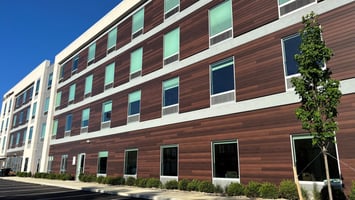With construction costs continuing to climb across Ohio, Indiana, and Kentucky, architects and...
4 Reasons to Use Thin Brick

Full bed masonry’s durability and classic aesthetic have made it a go-to for centuries, and its merits shine in most contexts. But its weight, cost, installation complexity, and reliance on a shrinking pool of skilled masons have forced architects to move away from brick to different claddings like fiber cement, metal cladding, EIFS, among other things. Thin brick offers a strategic alternative to preserve the classic aesthetic and adopt modern, affordable construction methods. Here are four reasons why using thin brick may be your best decision!
1. Building Renovations
Renovations often hit a structural wall: existing frameworks weren’t designed for full bed masonry’s 30-40 psf load. Adding a new footer can be impractical—space constraints, preservation codes, or budget realities often kill the idea. Thin brick, at 4-6 psf, sidesteps this issue. It adheres cleanly to substrates like CMU, drywall, or old plaster with minimal prep and zero reinforcement. Imagine an adaptive reuse project—a 19th-century factory turned mixed-use hub—or a heritage interior with a statement wall. Thin brick brings masonry’s depth and character without structural strain, balancing authenticity and feasibility for design-forward retrofits.
2. Jobsite Conditions
Jobsite challenges—tight schedules, limited room for rafters and lifts, or erratic weather—can derail full bed masonry’s labor-intensive workflow. Thin brick paired with precast concrete shifts production off-site, streamlining the process. Cast in controlled environments, these panels embed thin brick into lightweight concrete, arriving as finished units for rapid install. Picture mid-rise facades or institutional builds—think universities or civic centers—where consistent joints, no curing delays, and weatherproof assembly are non-negotiable. Unlike full bed’s field-stacking demands, this method tightens control and speeds timelines, making it a pragmatic fit for complex projects.
3. Brick as Cladding
Cladding focuses on finish, not structure, and full bed masonry’s heft feels like overkill. Thin brick’s ½-inch to 1-inch profile is purpose-built for this—light enough for curtain walls, adaptable to curves or interiors. Products like SpeedyMason elevates it with pre-spaced tiles and a mortar-ready backing, slashing install time by up to half. It’s perfect for rainscreen systems or interior focal points like lobby walls, delivering uniform coursing and authentic brick texture. For architects detailing a crisp commercial facade or a warm residential space, SpeedyMason merges design precision with on-site efficiency, outpacing traditional bricklaying.
4. Mason Shortage
The construction industry’s labor crunch—particularly the dwindling number of skilled masons—puts full bed masonry at a disadvantage. Its intricate, hands-on process leans heavily on expertise that’s increasingly scarce. Thin brick flips this dynamic. Its simpler installation—whether adhered directly or via systems like SpeedyMason, or processes like precast concrete—gives contractors the options to use other construction professionals, not just seasoned masons. This broadens the labor pool, reduces delays, and keeps projects on track. For a multi-phase development or tight-deadline retrofit, thin brick’s accessibility ensures masonry’s look without the workforce bottleneck.
The Thin Brick Edge
Thin brick isn’t a fallback; it’s a calculated win. It navigates renovation constraints, leverages precast for jobsite control, enhances cladding with SpeedyMason, and offsets the mason shortage by empowering a wider crew. Full bed masonry has its structural niche, but where load, speed, adaptability, or labor availability shape the spec, thin brick slots into the architectural toolkit—delivering masonry’s gravitas in a leaner, smarter package. Next time you’re sketching elevations or detailing a build, weigh it in. It’s a solution that adapts to the moment.


.webp?height=200&name=The-Grid-Edit2.jpg%20(1).webp)
